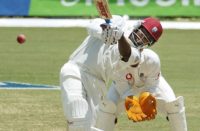Tim Wigmore focuses on the top end of the Tier Two game where two teams have dominated
For eight years, dating back to Afghanistan’s shock victory in the World Cup qualifiers in 2009, Afghanistan and Ireland have been adversaries on the pitch but allies off it, together showing the talent that exists beyond the ten Full Members and pushing world cricket, often seemingly in vain, to recognise as much. Their fierce rivalry has made both countries collaborate in exploring the limits of the sport’s potential beyond the Test world.
Until now, at least. After years of rising in unison, with Ireland generally a nose ahead, the two nations seem to be on very different paths, as exposed by Afghanistan thumping Ireland by an innings in the Intercontinental Cup, the first-class tournament for Associates that the Irish have come to regard as their own personal fiefdom.
It was one of the worst results in Irish cricketing history, made all the worse for not being entirely unexpected. As if that was not enough, Afghanistan A also beat a strong India U23s side on the same day, a window into the huge talent that exists even beneath the first team. Afghanistan’s potential as a cricketing nation is staggering.
The reasons for the divergence between the two leading Associates are not hard to identify. Afghanistan, having overcome overwhelming challenges, now find themselves better endowed on and off the field than any Associate nation since Sri Lanka, before their elevation to Test cricket 35 years ago, and, perhaps, even earlier.
Cricket is Afghanistan’s national sport, popular among all tribes. Their on-field success has given Afghanistan a fanaticism for cricket rivalling that of India and Pakistan. Their remarkable story, and the desperation of the world to support a good news story in the country, has opened up funding from the most unlikely of sources – Germany, Sweden and the USA have all been among the strong financial supporters of Afghan cricket.
Such funding enables Afghanistan, for all the huge challenges, to put together an ever-growing infrastructure for cricket. It allows them to fund elite training for their national players and those simmering under, funding a fantastic A-team and under-age programme alongside the national team’s commitments.
As well as being imbued with players and cash, Afghanistan are also fortunate to be in Asia. They have sagaciously built up a strong relationship with India, as shown by their home stadium moving there last year, and this geographic advantage has also given Afghanistan access to high-quality competition, notably the Asia Cup (where they can play the four Asian Full Members) and the Asian Cricket Council Emerging Teams Cup (the tournament in which their A-team defeated India U23s on the same day their first team thrashed Ireland).
What Ireland would give for such kind treatment by England, who have only deigned to send a below-par team to the Emerald Isle for a solitary day every two years – at least until this year when, just as Ireland look to have declined, England will finally host Ireland for a two-match ODI series.
More importantly, the lack of cash in Irish cricket means that the A-team has been dormant for years, so fringe players cannot get the exposure they need to improve. The A-team has a comparatively beefed up programme this summer, but it is still puny set against that of Afghanistan, who can afford to send their A-team to Zimbabwe for multi-format tours.
Most fundamentally of all, cricket is far more popular in Afghanistan than it is in Ireland where, for all the strides it has made in recent years, it remains far behind the country’s ‘big four’ – football, rugby union and the two Gaelic games. Irish cricket is perennially fighting with other sports for the attention of sports fans, or the most talented youngsters; Afghan cricket is almost monopolistic in the country’s sports market.
And yet, for all the temptation to map out these two different trajectories, and suggest that Afghanistan and Ireland will inevitably only diverge more in the future, perhaps this is a little too cute. Over the nine ODIs the two nations played last summer in Belfast and last month in Greater Noida, Afghanistan only won 5-4 – hardly the mark of emphatic superiority.
What’s more, they were aided by palpable fortune: in an Irish defeat in an ODI last summer, Mohammad Nabi claimed he was not behind the boundary rope when pulling the ball back – pictorial evidence makes patently clear that he lied – and then ran out Ed Joyce, who had been batting phenomenally well all series.
In the second ODI last March, Paul Stirling was on 95, seemingly leading Ireland to victory, when he was the victim of an umpiring howler, given out lbw to a ball probably missing the fifth stump, let alone the fourth, one of several decisions to go against Ireland in their 3-2 defeat.
Had the Joyce and Stirling decisions been correct, Ireland may well have won both ODIs and thus both series, by a combined margin of 6-3. Narratives of Irish decline and Afghanistan’s surge would, notwithstanding the Intercontinental Cup result, be much harder to construct.
And there are other mitigating factors, too: Boyd Rankin, Ireland’s most potent bowler, was absent from all nine ODIs (due to Warwickshire commitments and injury), while Rashid Khan, Afghanistan’s brilliant leg-spinner, played every game. Had the availability of the two kingpins been reversed then, even though Rankin could not be expected to match Khan’s impact, both series could have been very different, too.
The point here is not to deny that Afghanistan today are a superior cricket team to Ireland. It is to highlight that the margins have been less clear than the narrative suggests. Afghanistan still have much to improve upon; Ireland are a team with even more to do, but Irish cricket remains in infinitely better shape than in the pre-2007 dark ages.
For all that Ireland have been crippled by their over-dependence upon their golden generation, there are glimpses of this changing. Both Andy Balbirnie and Paul Stirling enjoyed an excellent tour. Both are 26, and should be the fulcrums of Irish batting for the next decade; Stirling has the potential to be one of the ten best ODI batsmen in the world – he was briefly ranked ninth four years ago – and a consistent match-winner.
The emergence of the generation of Irish batting below Balbirnie-Stirling is long overdue, although Lorcan Tucker, a 360-degree batsmen-wicketkeeper, is promising.
More encouraging, perhaps, is the long-term future of Irish bowling. While Ireland have lacked reliable support to Rankin and Tim Murtagh, and have still not replaced the tenacity and abrasiveness of Trent Johnston and John Mooney, there are a coterie of seam bowlers who hold out the promise of a brighter future.
Barry McCarthy, who performed well for Durham last season and took 18 wickets in seven home ODIs last summer yet was ignored in the ODIs against Afghanistan, should be an automatic selection. In a few years so should Josh Little, a 17-year-old left-armer who can reach 85mph and has been likened to Sam Curran, and Mark Adair, who is rated highly by Warwickshire.
All three are fine fielders and useful batsmen, too, and are likely to offer far more penetration than Peter Chase, who was exposed against Afghanistan. Leg-spinner Jacob Mulder remains raw but can turn the ball prodigiously, and has produced the occasional googly which hints at a special talent.
Everything points to Afghanistan having a brighter cricketing future than their rivals. Yet it is far too soon to state they have advanced to a level from which Ireland can never again match them. Afghanistan have earned the right to be seen as the standard-bearers for the Associate world, but they might still have plenty more enthralling tussles with Ireland ahead.
This piece originally featured in The Cricket Paper, April 7 2017
Subscribe to the digital edition of The Cricket Paper here















